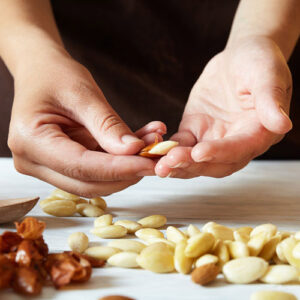using almonds
now browsing by tag
How to blanch almonds

Many almond recipes, especially in baking and patisserie, call for blanched almonds but they can be expensive to buy and are not always of the freshest quality. They also seem to come in really small packets.
So, what are blanched almonds, why are they better than whole raw almonds, and how to blanch almonds yourself at home?
What are blanched almonds?
Technically speaking, blanching is the culinary term for very briefly adding an ingredient to boiling water and then cooling it in cold water (refreshing).
Blanched almonds are almonds that have had their skins removed.
Although it is easy to remove the skin from other varieties of nuts by roasting them in the oven and rubbing them in a cloth or teatowel, almonds are fairly thick skinned so the process of blanching is the tried and tested method of removing their skins.
How to blanch almonds
Blanching almonds is a little fiddly, yet not difficult, and well worth the effort in terms of saving money and ensuring quality.
Bring a pan of water to the boil (size dependant on how many almonds you are blanching) and drop your almonds in. Leave for 1 minute and then drain in a sieve or colander. Return the almonds to the pan and run with cold water. Drain again. You may feel the water is useful for getting the skins off your fingers, which it is. Use a separate bowl for this though or you will find yourself mining for almonds in a pan of skins. Which is really frustrating.
Now that you have wet and wrinkly almonds with loose skins they are much easier to peel.
Pick up an almond between your thumb and forefingers. Gently squeeze so that the almonds pops out of the skin. Put the newly naked almonds on a tray lined with a clean dry cloth, and discard the skins. At this point you can leave them to dry for an hour or so, or place them in a very low oven for an hour to dry out further.
Blanched almonds that have been dried in the oven will grind to a finer flour and have more of a toasted nutty crunch than those that haven’t. Consider what you want to do with your almonds though, as sometimes you want a more creamy delicate flavour and a bit more moisture going on. Think frangipane and macarons.
You can store your blanched almonds for up to a month in an airtight container, in a cool dry place. Ideally though, you should blanch them as required.
What to do with blanched almonds
As previously mentioned, blanched almonds are non-negotiable for classic patisserie and more refined styles of baking. For when you want to whip up a moreish frangipane, or muster up a mass of candy coloured macarons. For these you want to grind raw blanched almonds into ground almonds.
The number one choice for gluten-free baking, almonds are exceptionally versatile and can be used in place of wheat flour very successfully in some recipes. You may want to experiment with making your own almond flour, and playing with different drying times and grinds.
You can blanch almonds before roasting if you wish. Or toss them in a dry frying pan until golden and toasty before decorating cakes and biscuits, or tossing in a salad.
Some people prefer to eat almonds without skins. There is no reason not to blanch almonds before snacking, or even making almond butter. The only time you really would not want to use blanched almonds is when making almond milk. It would simply be a waste of time.
Are blanched almonds healthy?
Almonds are officially a superfood. They provide essential minerals, mono-unsaturated fatty acids, and are one the best sources of antioxidant Vitamin E. The ideal beauty booster, they are of particular benefit to skin, hair and nails.
Almonds with the skin left on are higher in fibre and have more of the nutrient content intact. That said, blanched almonds are still super good for you.
Blanched vs unblanched almonds
Blanched almonds are not necessarily better than unblanched, whole raw almonds. They are just different and are best suited for certain purposes.
Sometimes you want raw and rustic, with more of a wholesome natural feel. Think crumbly speckled almond cookies made from the almond meal that you ground from the leftover pulp after making almond milk.
Other times you may want a substitute for wheat flour. Not only can specks of dark almond skin look less refined but can have a bitter taste and a drying sensation in the mouth. This is because almond skin is a source of tannins. The same compounds that cause the lip puckering sensation in black tea and red wine.
We recommend that you buy unblanched almonds, and then blanch them yourself when need be. Our Australian almonds are pesticide-free. One of Australia’s most important crops, sustainable almonds are vital for our economy and our wildlife.
If you are looking for cost effective ways to use blanched almonds then you could buy almonds in bulk. Or why not do all your bulk shopping at our online store?

 D5 Creation
D5 Creation